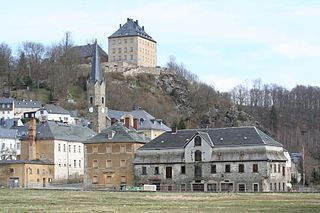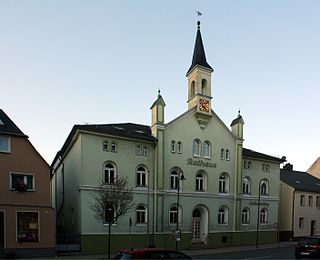| Sparnberg | |
|---|---|
| Ortsteil of Hirschberg | |
| Coordinates: 50°24′46″N11°46′16″E / 50.41278°N 11.77111°E Coordinates: 50°24′46″N11°46′16″E / 50.41278°N 11.77111°E | |
| Country | Germany |
| State | Thuringia |
| District | Saale-Orla-Kreis |
| Town | Hirschberg |
| Area | |
| • Total | 3.3 km2 (1.3 sq mi) |
| Population (2005) | |
| • Total | 160 |
| • Density | 48/km2 (130/sq mi) |
| Time zone | CET/CEST (UTC+1/+2) |
Sparnberg is a village in Thuringia, Germany. It was an independent municipality until 1994, when it became a district of the town Hirschberg. [1] It is situated on the right bank of the river Saale, at 440 m above sea level. It has an area of about 333 hectares. Sparnberg counted about 160 residents in 2005.

Thuringia, officially the Free State of Thuringia, is a state of Germany.

Germany, officially the Federal Republic of Germany, is a country in Central and Western Europe, lying between the Baltic and North Seas to the north, and the Alps to the south. It borders Denmark to the north, Poland and the Czech Republic to the east, Austria and Switzerland to the south, France to the southwest, and Luxembourg, Belgium and the Netherlands to the west.

Hirschberg is a town in the Saale-Orla-Kreis district, in Thuringia, Germany. It is situated on the river Saale, 20 km south of Schleiz, 12 km northwest of Hof (Bavaria), and 25 km southwest of Plauen (Saxony).

From 1949 to 1990 the Saale formed the border between East (GDR) and West Germany (FRG) here, with Sparnberg on the GDR side.

The Inner German border was the border between the German Democratic Republic and the Federal Republic of Germany from 1949 to 1990. Not including the similar and physically separate Berlin Wall, the border was 1,393 kilometres (866 mi) long and ran from the Baltic Sea to Czechoslovakia.

East Germany, officially the German Democratic Republic, was a country that existed from 1949 to 1990, when the eastern portion of Germany was part of the Eastern Bloc during the Cold War. It described itself as a socialist "workers' and peasants' state", and the territory was administered and occupied by Soviet forces at the end of World War II — the Soviet Occupation Zone of the Potsdam Agreement, bounded on the east by the Oder–Neisse line. The Soviet zone surrounded West Berlin but did not include it; as a result, West Berlin remained outside the jurisdiction of the GDR. It bordered West Germany to the west, Poland and the Czechoslovakia to the east and it lied between the Baltic Sea.

West Germany is the common English name for the Federal Republic of Germany in the period between its creation on 23 May 1949 and German reunification on 3 October 1990. It lied between the North Sea to the north, and the Alps to the south. It bordered Denmark to the north, East Germany and Czechoslovakia to the east, Austria and Switzerland to the south, France to the southwest, and Luxembourg, Belgium and the Netherlands to the west. During this Cold War era, NATO-aligned West Germany and Warsaw Pact-aligned East Germany were divided by the Inner German border. After 1961 West Berlin was physically separated from East Berlin as well as from East Germany by the Berlin Wall. This situation ended when East Germany was dissolved and split into five states, which then joined the ten states of the Federal Republic of Germany along with the reunified city-state of Berlin. With the reunification of West and East Germany, the Federal Republic of Germany, enlarged now to sixteen states, became known simply as "Germany". This period is referred to as the Bonn Republic by historians, alluding to the interwar Weimar Republic and the post-reunification Berlin Republic.

















